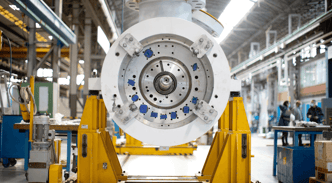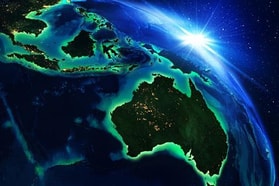Regional Markets: Focus on North Pacific Rim
Made in China. Made in Korea. Made in Japan. Made in Taiwan. So many of the products we encounter on a daily basis bear these familiar hallmarks – reflecting the economic dominance of the North Pacific
Rim countries.
This export-led example of dominance illustrates just why the North Pacific Rim (NPR) has been so affected by the global recession and its repercussions.
The various industrial gas markets in the region have been impacted too as a result, with the liquid gases business thought to have suffered in particular.
It all boils down to a drive to reduce costs, uncertain demand from wavering end-users, and the battered export economies of both Japan and China. In Japan alone for example, the sudden collapse of export sales, coupled with a spike in demand in commodity prices and an appreciation of the yen, left the country struggling.
Yet the countries and governments of the NPR have been quick to react to the onset of recession, with a sense of optimism and economic supremacy in the air. There had been an acute awareness of the rising economic power from the NPR region long before this latest recession.
This is a trend or situation exacerbated
by recession, as the financial crisis of the
West seas increasing power shifting to the
East and an acceleration of the global
economic evolution.
How does this translate for the gases business? If the usually buoyant steel, semiconductor, electronics and automotive industries recover and bounce back to prosperity, then industrial gas demand in the region will continue to flourish. The NPR is after all, the third largest market of the global industrial gas business, after North America and Western Europe.
The NPR market was valued at around $11.4bn in 2007, trailing behind North America with revenues of $18.8bn and Western Europe
at $17.3bn. Last year (2008) revenues in the NPR are thought to have reached just over $13.4bn, despite the drop-off experienced in the final quarter.
Japan
The fall in demand from the West had
struck a hammer blow to Japan’s export economy, including the electronics and manufacturing sectors.
With the country’s economy expected to contract by almost 6% this year, Japan could be one of the worst hit of the rich countries. However, the response to recession has been much deeper and faster this time around and an opportunistic outlook lies ahead.
Industrial output in the country increased 5.9% in May compared to April – with the output of cars, mobile phones and electronic devices particularly strong.
The emphasis for recovery has been on cost-cutting and an ever-growing zeal for mergers
and acquisitions.
An example of this could be the planned business tie-up between Koike Sanso Kogyo and Taiyo Nippon Sanso’s Nissan Tanaka. As reported in The Gas Review and gasworld magazine earlier this year, the two companies have entered negotiations over the joint venture which would create a new company in the cutting & welding field.
Koike Sanso Kogyo and Nissan Tanaka have been competitors in the welding & cutting machines business for some time, but both are believe to be keen on the development capabilities, synergetic effects, and cost reductions achieved as part of the new fusion.
In terms of gases, Japan is still something of an elder statesman from an industrial gas business perspective.
The market was worth just over $7.8bn in 2008 and is far more mature when compared to its Chinese neighbour, at just $3.46bn. So vast are the Japan industrial gas revenues that the country accounts for 59% of the NPR market, dwarfing the gas industries of China, Taiwan, South Korea, and North Korea – according to estimated figures from Spiritus Consulting.
China
With the People’s Republic in the shade of Japan in terms of industrial gas revenues, why all the fuss about China?
Perhaps it’s because China won’t be in the shade for much longer. Much talk has elapsed about the rise of China as an industrial gas player and with the country coming to the economic fore so prominently, this is likely to be justified.
Despite falling exports, China’s economic growth has remained relatively strong in 2009, thanks to a surge in investment thought to be augmented by government stimulus. China stands out so profoundly that it is seen as the only major country maintaining a growth in
its GDP.
As well as providing an investment boost, the government stimulus may add another dimension of gas demand for our industry.
As a developing economy, China still lacks a sound infrastructure and railways in particular are thought to be something of a problem. As part of the government spending, investment in the roads, power grid and water systems is intended to sustain China’s rapid growth – which should also yield increased gas demand.
Praxair China President, David Chow, would appear to concur with this notion. Praxair China is already serving emerging applications such as water treatment and Chow explained in our exclusive interview this month, The environment-friendly applications, for sure, are significant for us in the Chinese marketplace, which is addressing increasing demands for such technology to achieve sustainable development.”
“We focus on the fast growing segments of the industry. Wastewater treatment is certainly an emerging area that we are working hard at developing.”
Developing is very much the buzz word in the People’s Republic. Developing technologies, developing economy, and a developing
gases industry.
It seems apt that we should now focus on the Chinese gases business, given that the 60th anniversary of the formation of the People’s Republic of China lies ahead next month – 60 years since the last Chinese civil war.
The country’s economy and industrial gas business has come a long way since then. The Chinese gas market was valued at around $3.4bn in 2008, representing a 26% share of the NPR market overall. While that may only be around half the size of the Japan market, it’s more than four times the size of the South Korean gases industry and almost three times the value of Taiwan gas revenues.
Electronics and manufacturing are the key drivers here, especially the huge manufacturing hub of China. The manufacturing sector accounts for almost 33% ($4.38bn) of all end-user revenues in the NPR. Electronics makes-up a 24% ($3.1bn) share of end-user gas revenues.
Air Liquide, together with Linde as the two more involved majors in the Chinese market, has shown how strong the electronics sector is with the award of a number of lucrative contracts. The company has signed a number of photovoltaics (PV) gas supply contracts in the NPR region, ready to capitalise on an expected wave of growth in 2010.
Air Liquide also revealed it is to invest in a €25m ASU in China’s Sichuan Province, to provide gases for the region’s leading TFT-LCD manufacturers.
Meanwhile, soft drinks manufacturer PepsiCo appears confident about the potential ahead for the Chinese market, with the news that it has reiterated plans to invest $1bn in the country.
Affirming its belief in the Chinese beverages industry, PepsiCo opened its first overseas ‘green’ plant in the western city of Chongqing – a state-of-the-art beverage facility which illustrates the company’s strategy to invest in emerging markets.
It’s thought that PepsiCo plans to fund a number of capital programmes to grow its manufacturing capacity in China. Over the next two years the company expects to open five new beverage production plants in the country, in Kunming, Zhenzhou, Quanzhou, Lanzhou, and Nanchang.
PepsiCo Chairman and CEO Indra Nooyi underlined the belief in China, “Despite the current uncertainty in many parts of the world, we have no doubt that China will remain a powerful engine of global economic expansion. This is the largest, most ambitious development effort we’ve undertaken in our more than 25 years of doing business here.”
Taiwan
As the third largest industrial gas market in the NPR region, Taiwan accounts for an 8.6%
share and boasts a gases business worth around $1.15bn.
Merchant demand for oxygen, nitrogen, argon and carbon dioxide is estimated to have reached its highest levels in recent years, as demand from metal fabrication, cutting & welding and heavy engineering industries drives demand. And that’s just for oxygen.
Primary metals production, petrochemicals, waste water treatment and medical applications were thought to have accounted for around 45% of total merchant oxygen demand in recent years.
Electronics is perhaps the biggest and most burgeoning sector in Taiwan, an industry that the country is most famed for. As an example of how strongly this drives gas demand, as recently as 2004 electronics was estimated to account for just under 25% of the total 2.500 tpd merchant market for nitrogen.
Similarly, merchant demand for argon is believed to be high from the electronics and scientific research markets. Additionally, these estimates were from 2004 – in the just five years to have passed since then, the electronics and solar cells sector has rapidly evolved and experienced a major boom.
With the expected recovery and continued surge of the electronics industry, this is most likely to drive forward the development and soaring growth of the Taiwan, Chinese, Japanese and North Pacific Rim industrial gas markets in the future.
... to continue reading you must be subscribed










